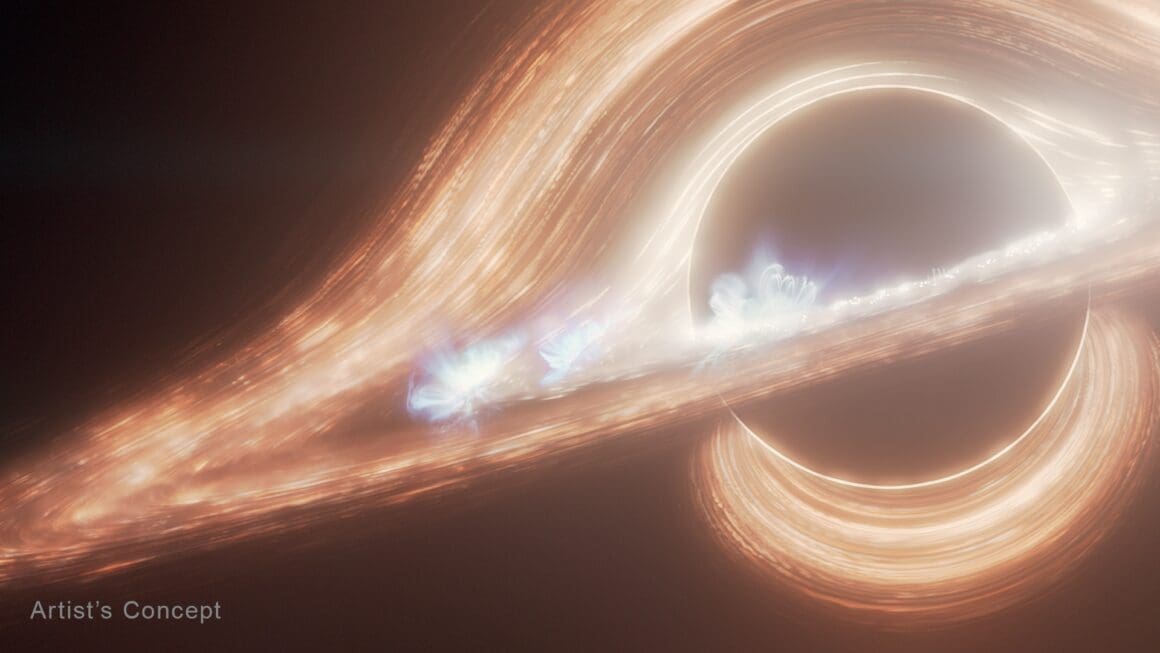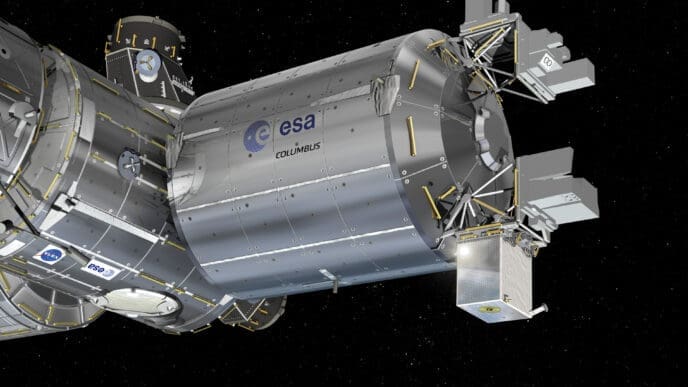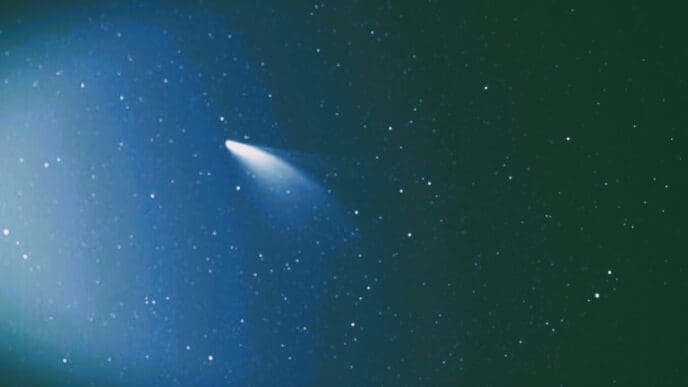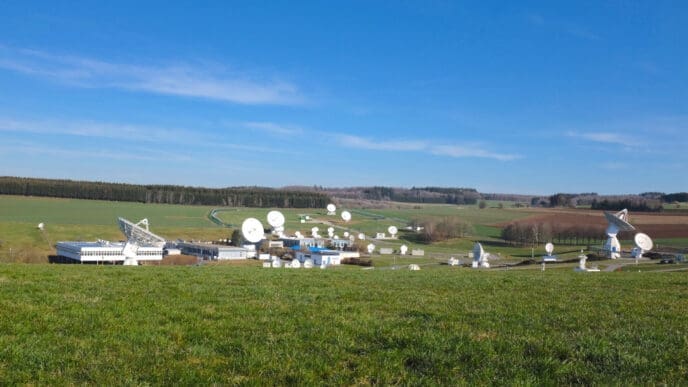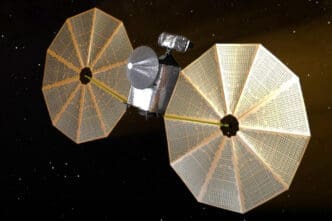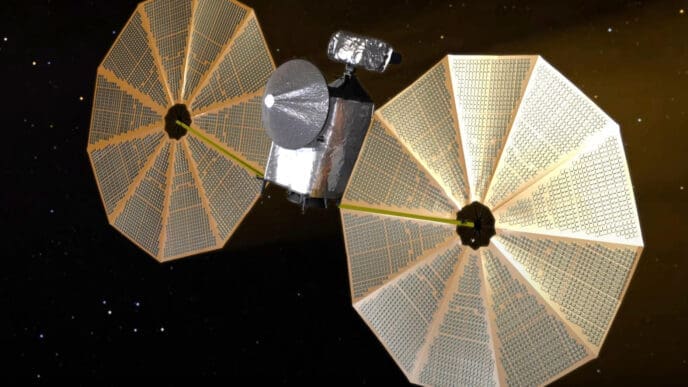NASA’s James Webb Space Telescope is causing quite the buzz with its latest discovery. It has unveiled a spectacular light show orchestrated by the supermassive black hole at the center of our Milky Way. The central black hole, Sagittarius A*, is not just a mysterious dark void. It’s now revealed to be a dynamic and lively part of our galaxy.
Through Webb’s powerful lenses, we are witnessing a cosmic party unlike any other. This black hole is surrounded by a swirling disk of hot gas and dust. Flares of all sizes light up in rapid-fire sequences, creating a celestial dance that’s both random and breathtaking. This show of lights is not only captivating to watch but also holds the key to understanding the secrets of black holes.
Flaring Disk and Dazzling Displays
The artist’s concept of the supermassive black hole, Sagittarius A*, reveals a swirling accretion disk of hot gas and dust. This disk is not just a visual marvel but a bustling place. It’s alive with activity, similar to solar flares, but on a much grander and more intense scale. The gravity of the black hole bends the light, creating an exquisite visual spectacle.
NASA’s James Webb Space Telescope has detected a rapid succession of flares and flickers emanating from Sagittarius A*. These light shows, some occurring in mere seconds, originate close to the black hole. The intense activity presents a challenge and an opportunity for astrophysicists to decode the enigmatic behavior of these cosmic giants.
Random Fireworks in the Cosmos
Far from predictable, the activity around Sagittarius A* is like an endless fireworks show. Yusef-Zadeh, leading the team, utilized Webb’s NIRCam to capture this spectacle for 48 hours over a year. The unexpected outcome was the variety and frequency of the flares, contradicting prior expectations. Five to six major flares and numerous minor bursts were observed daily.
The discovery has scientists scratching their heads, eager to understand what drives such unpredictable energy. This randomness challenges existing theories and pushes the boundaries of what’s known about black hole accretion disks.
Sagittarius A* has become a case study, demonstrating the extremities of black hole environments. Each observation adds another piece to the puzzle, slowly revealing the complexity behind these massive flares and the quieter sub-flares that dance across the cosmic sky.
Understanding the Processes Within
Astrophysicists propose that two distinct processes might explain the light shows. The fainter flickers are thought to be caused by turbulent fluctuations within the accretion disk. These disturbances compress plasma, creating bursts of radiation, akin to solar flares but far more intense.
Yusef-Zadeh explains this phenomenon: “It’s similar to the Sun’s surface bubbling with activity.” It’s the black hole’s extreme environment that makes these processes so dramatic.
The larger spectacles, however, likely stem from magnetic reconnection events. These collisions release enormous amounts of energy, accelerating particles to almost light speed and producing bright bursts of radiation that captivate scientists and audiences alike.
These insights are not just academic; they deepen our understanding of cosmic mechanics at their most fundamental level.
Dual Vision and Delays
This breakthrough had scientists buzzing. By watching different wavelengths, they learned new details about how particles behave near the black hole. The tiny delay provided implications for the physics of black hole flares, crucial for all future research.
Hopes for Continued Observation
Yusef-Zadeh and his team have planned future observations to continue unraveling Sagittarius A*’s mysteries. The aim is to have an uninterrupted 24-hour observation period. Such clarity could lower noise interference and reveal details previously hidden among the flaring.
The James Webb Space Telescope is equipped like no other, ready to dive deeper than ever into these cosmic mysteries. Already, its discoveries are reshaping our understanding of not just our galaxy but the universe at large.
Scientific communities eagerly anticipate the potential findings of these extended periods of observation. The hope is to discern whether patterns exist in these flares or if their randomness continues to surprise.
Webb’s Impact on Cosmic Exploration
The James Webb Space Telescope holds the key to solving some of the universe’s most complex puzzles. It’s not just analyzing Saturn’s rings or distant exoplanets; it’s plunging into the depths of the cosmic unknown, bringing us face-to-face with phenomena like black hole flares.
These discoveries are vital. They’re redefining our grasp of astrophysical processes and the fundamental laws that govern space.
The Webb Telescope is a collaborative triumph, supported by NASA, ESA, and CSA, continually pushing boundaries and expanding the horizons of human knowledge.
The Universe’s Endless Mysteries
The universe is vast and filled with wonders just waiting to be unraveled. The Webb Telescope is positioned to peel back these layers and bring into focus what was once too distant or advanced for previous technologies.
Astrophysicists are thrillingly close to breakthroughs that seemed impossible before, making each revelation a window into the unseen mechanics of space.
The exploration of Sagittarius A* is just the beginning, paving the way for deeper insights into black holes and galaxy evolution.
As we peer into our galaxy with the James Webb Space Telescope, the image of black holes as dark voids fades away. They are vibrant, ever-changing enigmas, offering glimpses into the universe’s core mysteries.


